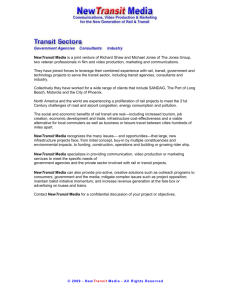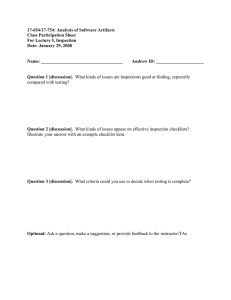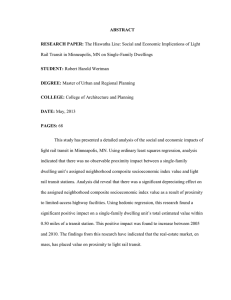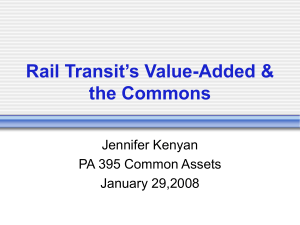Heating, Ventilation and Air Conditioning Periodic Inspection and
advertisement
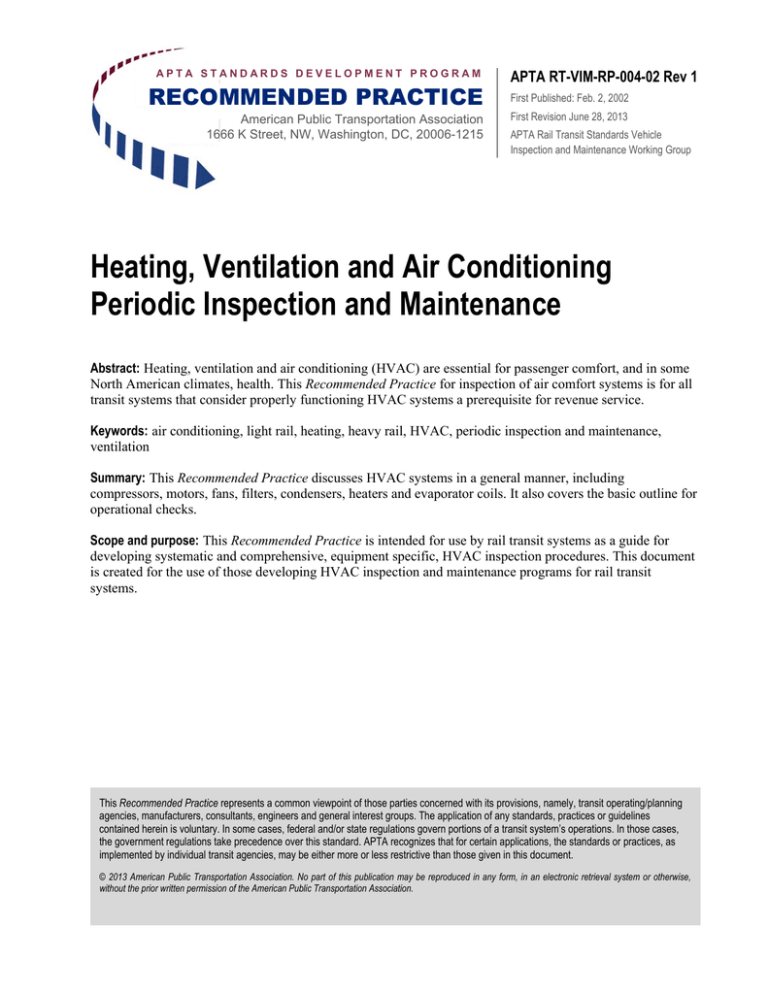
APTA STANDARDS DEVELOPMENT PROGRAM RECOMMENDED PRACTICE American Public Transportation Association 1666 K Street, NW, Washington, DC, 20006-1215 APTA RT-VIM-RP-004-02 Rev 1 First Published: Feb. 2, 2002 First Revision June 28, 2013 APTA Rail Transit Standards Vehicle Inspection and Maintenance Working Group Heating, Ventilation and Air Conditioning Periodic Inspection and Maintenance Abstract: Heating, ventilation and air conditioning (HVAC) are essential for passenger comfort, and in some North American climates, health. This Recommended Practice for inspection of air comfort systems is for all transit systems that consider properly functioning HVAC systems a prerequisite for revenue service. Keywords: air conditioning, light rail, heating, heavy rail, HVAC, periodic inspection and maintenance, ventilation Summary: This Recommended Practice discusses HVAC systems in a general manner, including compressors, motors, fans, filters, condensers, heaters and evaporator coils. It also covers the basic outline for operational checks. Scope and purpose: This Recommended Practice is intended for use by rail transit systems as a guide for developing systematic and comprehensive, equipment specific, HVAC inspection procedures. This document is created for the use of those developing HVAC inspection and maintenance programs for rail transit systems. This Recommended Practice represents a common viewpoint of those parties concerned with its provisions, namely, transit operating/planning agencies, manufacturers, consultants, engineers and general interest groups. The application of any standards, practices or guidelines contained herein is voluntary. In some cases, federal and/or state regulations govern portions of a transit system’s operations. In those cases, the government regulations take precedence over this standard. APTA recognizes that for certain applications, the standards or practices, as implemented by individual transit agencies, may be either more or less restrictive than those given in this document. © 2013 American Public Transportation Association. No part of this publication may be reproduced in any form, in an electronic retrieval system or otherwise, without the prior written permission of the American Public Transportation Association. Contents Introduction 1. Frequency of conduct ........................................................................ 1 Participants The American Public Transportation Association greatly appreciates the contributions of Daniel Wilson, who provided the primary effort in revising this Recommended Practice. At the time this document was revised, the working group included the following members: Jayendra Shah, Chair Ken Morford, Vice Chair Vicki Porter, Secretary Dave Barber Damian Barnhart, Sherif Bastawros Richard Berk Steve Bethel Jerry Blackman Stephen Bonina Lisa Cobb John Condrasky Richard Curtis Paul Denison Phil Eberl Bill Egan Chris Eichin Marc Gagne Curt Grau John Green Scott Grogan iii Terry Hildebrandt Ben Holland Paul Jameison Rick Kinding Henry Kolesar Paul Kovacs Brian Ley John MacEwen John Sadorra Richard Seaton George Shaffer John Shea, Jr. Melissa Shurland Michelle Swayzer Clive Thornes Wilson Wallace Michael Wetherell 2. Requirements and specific tasks ..................................................... 1 2.1 Materials ...................................................................................... 2 2.2 Tools ............................................................................................ 2 2.3 Safety/personal protective equipment .......................................... 2 2.4 Training requirements .................................................................. 2 2.5 Inspection and maintenance ......................................................... 3 2.6 Correction of deficiencies ............................................................ 5 References .............................................................................................. 6 Abbreviations and acronyms ............................................................... 6 Summary of document changes .......................................................... 6 Document history ................................................................................... 6 Project Consultant: Gordon S. Campbell Interfleet Technology Inc. Project Team: Charles Joseph American Public Transportation Association © 2013 American Public Transportation Association | ii APTA RT-VIM-RP-004-02 First Revision June 28, 2013 Heating, Ventilation and Air Conditioning Periodic Inspection and Maintenance Introduction This introduction is not a part of APTA RT-VIM-RP-004-02 First Revision June 28, 2013, Standard for Heating, Ventilation and Air Conditioning Periodic Inspection and Maintenance. This Recommend Practice for Heating, Ventilation and Air Conditioning Periodic Inspection and Maintenance for rail transit vehicles represents a common viewpoint of those parties concerned with its provisions, namely, transit operating/planning agencies, manufacturers, consultants, engineers and general interest groups. The application of any standards, practices or guidelines contained herein is purely voluntary. In some cases, federal and/or state regulations govern portions of a rail transit system’s operations. In those cases, the government regulations take precedence over these recommended practices. APTA recognizes that for certain applications, the standards or practices, as implemented by individual rail transit systems, may be either more or less restrictive than those given in this document. This Standard is intended to assist RTS personnel in performing basic maintenance and inspection procedures on rail transit door systems. Since each rail transit rail cars may be different, the procedures and steps described in this document will not necessarily be applied to, nor required for, every RTS maintenance and inspection procedure. APTA recommends the use of this standard by: y y y Individuals or organizations that operate rail transit systems; Individuals or organizations that contract with others for the operation of rail transit systems; and Individuals or organizations that influence how rail transit systems are operated (including but not limited to consultants, designers and contractors). © 2013 American Public Transportation Association iii APTA RT-VIM-RP-004-02 First Revision June 28, 2013 Heating, Ventilation and Air Conditioning Periodic Inspection and Maintenance Heating, Ventilation and Air Conditioning Periodic Inspection and Maintenance 1. Frequency of conduct Periodic inspection and maintenance tasks on the HVAC systems should be performed on regularly scheduled intervals as determined by the rail transit system. The frequency of any task contained within periodic maintenance and inspection should comply with all applicable federal, state and local regulations. Further, in the conduct of a rail transit system’s periodic inspection and maintenance programs, frequencies for individual tasks may be established based on a number of additional factors, including but not limited to: y y y y y y y y OEM-recommended intervals; industry experience; operating environment/conditions; historical data; performance requirements; failure analysis; rail transit system’s testing and experience; and Reliability-centered maintenance programs. 2. Requirements and specific tasks NOTE: Release of refrigerant into the atmosphere is illegal. All personnel conducting repair, recovery or evacuation on HVAC systems must possess current EPA certification according to Section 608 of the Clean Air Act of 1990, as amended. WARNING: Only trained and qualified personnel should work on HVAC systems. High voltage, high pressure, rotating equipment, chemical hazards and extremes of temperature are present and can cause serious personal injury. All precautions mandated by the rail transit system and federal, state and local regulatory agencies, including the wearing of personal protective equipment, must be followed. WARNING: Compressed air used for cleaning must be reduced to less than 30 psi, according to OSHA 29 CFR 1910.242b. WARNING: Use only those cleaning products and lubricants proved safe and authorized for use by the rail transit system. Consult original equipment manufacturer (OEM) and Material Safety Data Sheet (MSDS) references for suitability of each application to prevent personal injury and damage to the equipment. © 2013 American Public Transportation Association 1 APTA RT-VIM-RP-004-02 First Revision June 28, 2013 Heating, Ventilation and Air Conditioning Periodic Inspection and Maintenance 2.1 Materials The following materials are normally required for inspection and maintenance of HVAC systems: y y y y y y OEM and rail transit system manuals, including schematics and drawings; cleaning solutions; lubricants as approved by OEM ; refrigerant as specified by OEM; compressed air; and filters and filter dryers as specified by OEM. 2.2 Tools The following tools are typically required for inspection and maintenance of HVAC systems: y y y y y y y y y y y recovery/evacuation unit and recovery Cylinder;* refrigeration service gauges;* vacuum pump; mechanics toolbox; special tools; Volt Ohm Meter* electronic, ultrasonic or ultraviolet leak detector, or other leak identification device;* air flow hood, anemometer or other velocity/volume-measuring device;* portable test unit; scale, to weigh quantity of refrigerant installed and/or recovered; and temperature measuring device. NOTE: Tools marked with an asterisk require periodic calibration as specified by the rail transit system’s practices. 2.3 Safety/personal protective equipment Appropriate personal protective equipment, meeting minimum ANSI standards and as required by the rail transit system, shall be worn at all times in the performance of these inspection and maintenance tasks. 2.4 Training requirements Rail transit systems and/or their maintenance contractors should develop and execute training programs that provide employees with the knowledge and the skills necessary to safely and effectively perform the tasks outlined in this Recommended Practice. These programs should include but not limited to the following: y y y y y y y y y y Fundamentals of Refrigeration On Car System Operation Description, Location, Operation, and Function of each Line Replaceable Unit (LRU) System Evacuation and Dehydration System Pump-Down and Charging Principals of HVAC Controls Safety Devices and Lockouts HVAC Mechanical and Electrical Schematics Preventive Maintenance Troubleshooting and System Calibration © 2013 American Public Transportation Association 2 APTA RT-VIM-RP-004-02 First Revision June 28, 2013 Heating, Ventilation and Air Conditioning Periodic Inspection and Maintenance y y y Corrective Maintenance Maintenance and Operation Safety Hazards EPA 608 Certification Training 2.5 Inspection and maintenance The following suggested inspection and maintenance procedures are intended for use in conjunction with the OEM’s recommended inspection and maintenance procedures. In the event of a conflict between this Recommended Practice and the manufacturer’s recommendations, the manufacturer’s recommendations should prevail. 2.5.1 System de-energized inspections Microprocessor fault data logs and vehicle maintenance history files should be available and reviewed before work begins. Diagnostic information can pinpoint components that are repeatedly failing, perhaps intermittently. Troublesome components can be identified and receive more detailed inspection and functional checks. 2.5.1.1 General mechanical inspections a. b. c. d. Inspect housing latches/fasteners for damage and security. Replace/repair as required. Inspect housing seals for integrity and air bypass. Inspect housing, panels and structure for corrosion. Inspect fresh air and return air filters, louvers and grilles. Clean or replace according to OEM instructions or rail transit system requirements. e. Inspect all mechanical mounting components for damage and security. 2.5.1.2 Compressor a. For open-drive compressors, check the drive/motor coupling for security, proper alignment and excessive wear and play. b. Verify oil level in accordance with OEM procedures. c. For open drive compressors, check compressor shaft seal for refrigerant leakage. Repair or replace when leakage exceeds OEM recommendations. d. Check for refrigerant leakage on compressor fittings, gaskets and seals. e. Refer to APTA Recommended Practice APTA RT-RP-VIM-010-02, “Electrical Motor Periodic Inspection and Maintenance,” for motor inspection. f. Extract oil sample where possible and acid test for proper color and acid content. 2.5.1.3 Piping a. Inspect piping for dirty or oily areas. Clean those areas and then use a leak detector to check for leaks. Repair as required. b. Check indicator on filter/dryer and replace dryer if it indicates moisture in the system. c. Clean all drain pans, drain pipes and nozzles. Inspect for leaks and repair as necessary. d. Ensure that all drains are free-running. e. Check condition of vibration-eliminator piping. f. Ensure that expansion valve sensing bulbs are in correct location and in firm contact with evaporator discharge line, where possible without removing insulation. g. Check for integrity and proper installation of piping insulation. © 2013 American Public Transportation Association 3 APTA RT-VIM-RP-004-02 First Revision June 28, 2013 Heating, Ventilation and Air Conditioning Periodic Inspection and Maintenance 2.5.1.4 Condensers and evaporators a. Clean the condenser and evaporator coils and fins with compressed air according to 29 CFR 1910.242(b), or use an appropriate cleaning solution. If desired, the effectiveness of cleaning can be measured as a function of pressure drop across the condenser; rail transit system experience and OEM recommendations can establish the appropriate level. b. Inspect for damage to fins and coils, and evidence of leaking. Repair per OEM instructions. c. Clean and inspect all fan blades. Check that fans rotate freely and without obvious bearing noise. d. Clean evaporator drain pans and drain lines. 2.5.1.5 Electrical a. b. c. d. e. f. Inspect wiring for chaffing or other damage, and tighten any loose connections. Inspect fusible link for continuity and/or damage. Verify operation of evaporator airflow switch device If applicable, inspect all motor commutator and brushes and brush holders, replace as necessary. Lubricate motors, if required. If heaters are checked with a resistance test, verify resistance values. Check that properly rated fuses are installed in the heating system. Verify that heating resistance element mounting, insulators and hardware are properly installed and not damaged. g. Inspect all contactors, contactor coils for cleanliness and integrity. h. Perform insulation resistance test on high-voltage circuits. i. Inspect contactor tips for signs of arcing. j. Refer to APTA Recommended Practice APTA RT-RP-VIM-010-02, “Electrical Motor Periodic Inspection and Maintenance,” for motor inspection. 2.5.2 System-energized functional tests 2.5.2.1 Controller a. Verify correct controller software version is installed. b. Verify correct operation of controller using an operational test that verifies appropriate control modes. c. Where hard logic is used, check contactor operation. 2.5.2.2 Refrigerant circuit operation a. Perform an operational (functional) check of the HVAC system. Monitor gauge pressures versus vehicle temperature to determine acceptable operation. This procedure is done by cycling the HVAC unit through its various cooling modes by simulating ambient and in-car temperatures through the use of a computer or other portable test unit. b. Verify that airflow is sufficient. c. Check refrigerant level in receiver sight glass, if unit is so equipped. d. Verify proper condensate flow. e. Verify pump down on reciprocating compressor systems. f. Verify superheat at evaporator suction line, if equipped with adjustable thermal expansion valves. g. Verify no flash gases (bubbles) in liquid line sight glass, if unit is so equipped. NOTE: Flash gases may be indicative of a low refrigerant charge or a piping restriction. h. Check proper pressure switch operation, as required. i. Inspect for icing along suction lines, thermal expansion valves and at the evaporator. © 2013 American Public Transportation Association 4 APTA RT-VIM-RP-004-02 First Revision June 28, 2013 Heating, Ventilation and Air Conditioning Periodic Inspection and Maintenance 2.5.2.3 Heaters a. Verify that all heaters are operational and are heating the air as required. This may be done by checking heater resistance when not in operation, by checking power consumption in operation, or by checking the temperature near the heater. b. Check resistance to ground. c. Verify heater contactor operation. 2.5.2.4 Mechanical a. Check for excessive vibration or noise while in operation. b. Check compressor oil for proper color and level. Perform acid test as required. c. Check unloaders for proper setting and operation. 2.6 Correction of deficiencies Any deficiencies uncovered during the inspections required in Section 2.5.1 through 2.5.2 should be corrected and documented in accordance with rail transit system procedures and OEM recommendations. © 2013 American Public Transportation Association 5 APTA RT-VIM-RP-004-02 First Revision June 28, 2013 Heating, Ventilation and Air Conditioning Periodic Inspection and Maintenance References American Public Transportation Association Recommended Practice: • APTA RT-VIM-RP-010-02, “Electrical Motor Periodic Inspection and Maintenance” (Document was previously numbered as APTA RT-RP-VIM-0-02) Code of Federal Regulations, 29 CFR 1910.242(b), Compressed Air Used for Cleaning. U.S. Environmental Protection Agency, Clean Air Act (CAA) of 1990, as amended, Section 608. Abbreviations and acronyms ANSI CAA CFR EPA HVAC MSDS OEM OSHA psi American National Standards Institute Clean Air Act Code of Federal Regulations United States Environmental Protection Agency heating, ventilation and air conditioning Material Safety Data Sheet original equipment manufacturer Occupational Safety and Health Administration pounds per square inch Summary of document changes 1. 2. 3. 4. Document formatted to the new APTA standard format. Sections have been renumbered and moved around. Two new sections added, “Summary of document changes and “Document history” Some global changes to section headings and numberings resulted when sections dealing with references and acronyms were moved to the end of the document and other cosmetic changes, such as capitalization, punctuation, spelling, grammar and general flow of text. 5. Changes in the following sections: a) 2.1 Materials – added references to OEM b) 2.2 Tools – added Volt Ohm Meter c) 2.4 Training Requirements – listing of areas of training programs d) 2.5.1.5 Electrical – added verify operation of airflow switch e) 2.5.2.4 Mechanical – added perform acid test Document history Document Version First published First revision Working Group/Task Force Vote Public Comment/ Technical Oversight CEO Approval Policy & Planning Approval Publish Date July 2001 - - Jan 24, 2002 Feb 2002 1st Qtr 2013 March 2013 May 14, 2013 June 14, 2013 June 28, 2013 © 2013 American Public Transportation Association 6
